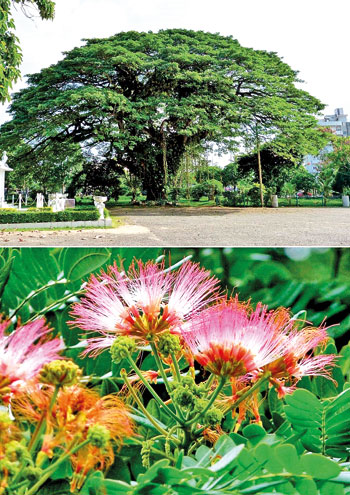The shade tree

This tree can be identified readily by its umbrella-shaped, wide, dense crown and pink, powder puff-like flowers. Pix by the author
Albizia saman
- Common/ English name: Rain tree
- Family: Fabaceae (The bean family)
- Sinhala name: Para mara; Tamil name: Nilal vahai
This is an unmistakable tree – with a massive, deeply-furrowed trunk and a very wide, umbrella-shaped, dense crown, which is broader than the height of the tree (25 m). This grows along roadsides in many parts of the island. There is a stretch of iconic rain trees along Kumaratunga Munidasa Mawatha (formerly Thurstan Road).
The foliage is thick and the leaves are divided into dark olive, slightly diamond-shaped leaflets. In full sunlight, these leaflets are flat and open but when it becomes cloudy or dark, these leaflets fold on each other and droop. This is why it is called a rain tree.
What appears to be a powder puff-like flower is a bunch of many, tiny, pink, tubular flowers. The flowering season is usually from March to May. During this time, these impressive crowns are dotted with pink. Fruits are brown pods, eaten by squirrels and birds.
This native of Central and South America was introduced to Sri Lanka in the mid-19th century. Apparently, this species was introduced to Sri Lanka to provide railway fuel but the wood was not suitable for burning. However, it can be used for furniture and the leaves and pods as fodder. In Sri Lanka, its main purpose has been as a shade tree along roadsides.
However, road widening and ad hoc development activities are resulting in the destruction of these magnificent trees.
 Extracted from ‘What tree is that? The Ruk Rakaganno Layperson’s Guide to Some Trees of Sri Lanka’. Updated by the author using ‘Grown in Sri Lanka: cultivated flowering plants’ by Sriyanie Miththapala, Janaki Galappatti, and Siril Wijesundara (2015). The National Trust: Colombo.
Extracted from ‘What tree is that? The Ruk Rakaganno Layperson’s Guide to Some Trees of Sri Lanka’. Updated by the author using ‘Grown in Sri Lanka: cultivated flowering plants’ by Sriyanie Miththapala, Janaki Galappatti, and Siril Wijesundara (2015). The National Trust: Colombo.
Searching for an ideal partner? Find your soul mate on Hitad.lk, Sri Lanka's favourite marriage proposals page. With Hitad.lk matrimonial advertisements you have access to thousands of ads from potential suitors who are looking for someone just like you.


